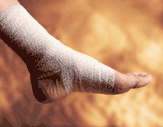
Primary symptoms of ankle sprains are pain following a twist or injury, swelling, and bruising.
Treatment includes resting and elevating the ankle and applying ice to reduce swelling. Compressive bandages also may be used to immobilize and support the injury during healing. Serious ankle sprains, particularly among competitive athletes, may require surgery to repair and tighten the damaged ligaments.
To prevent ankle sprains, try to maintain strength, balance, and flexibility in the foot and ankle through exercising, stretching, and wearing well-fitted shoes.
Chronic Lateral Ankle Pain
Chronic lateral ankle pain is recurring or chronic pain on the outside part of the ankle that often develops after an injury such as a sprained ankle.
Signs and symptoms include:
- Ankle instability.
- Difficulty walking on uneven ground or in high heels.
- Pain, sometimes intense, on the outer side of the ankle.
- Repeated ankle sprains.
- Stiffness.
- Swelling.
- Tenderness.
Although ankle sprains are the most common cause of chronic lateral ankle pain, other causes may include:
- A fracture in one of the bones that make up the ankle joint.
- Arthritis of the ankle joint.
- Inflammation of the joint lining.
- Injury to the nerves that pass through the ankle. In this case, the nerves become stretched, torn, injured by a direct blow, or pinched under pressure.
- Scar tissue in the ankle after a sprain. The scar tissue takes up space in the joint, putting pressure on the ligaments.
- Torn or inflamed tendon.
Treatments for chronic lateral ankle pain include:
- Over the counter or prescription anti-inflammatory medications to reduce swelling. Note: Please consult your physician before taking any medications.
- Physical therapy, including tilt-board exercises that focus on strengthening the muscles, restoring range of motion, and increasing your perception of joint position.
- Ankle braces or other supports.
- Steroid medication.
- Immobilization to allow the bone to heal (in cases of fractures).
